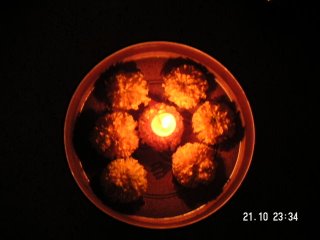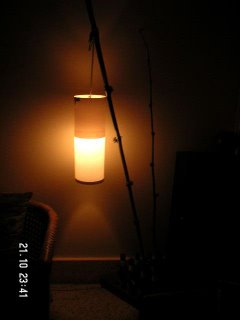Folk Mela @ Bangalore
Karnataka Chitrakala Parishat (KCP) situated in the heart of Bangalore at Kumara Krupa Road,near to the Bangalore Golf Course area hosted the Folk Mela from 20th -24th Oct’06. KCP is well connected by local transport. Spread over a spacious three acre area with imaginative landscaping, creative planning and the traditional village architectural style, the campus provided the perfect ambience for a Folk Mela. A plaza paved with stone and brickwork skillfully interspersed with grass, flowering shrubs and green trees, plus a food court conjured up an oasis for visitors.



The Folk Mela was organized by Kala Madhyam and Infosys Foundation was one of the chief sponsors for the Mela.

In the present age of fast modern life, cultural artists are fast losing their place in society. People have no time or interest in these artists, and there is considerable pain and a sense of hopelessness in these marginalized people. By showing an interest in their folk arts and folk traditions, Kala Madhyam tries to give them back their pride and means of livelihood. India has an amazing number of artisans dealing with myriad genres any country would be proud to have. But somehow they are pushed to the background. The main intention of this Mela was to showcase the folk art and culture and help artisans market their products and make their tradition a sustainable occupation.
A wide variety of skillfully crafted handicrafts, intrinsic to each part of the country was available in this exotic Mela. These range from intricate rosewood and sandalwood carvings, embellished camel hide footwear, to sophisticated fabric and drapery. Gems, beads, brassware, metal crafts, silk and woolens. The range was limitless.




The tradition of iron craft in Madhya Pradesh has been passed down from generation to generation and stands unmatched in skill and creativity. The iron craft of this region has a unique rustic charm. Excelling in iron sculptures, the craftsmen of the region experiment with each and every theme traditional or imaginary. The themes include local deities, armed tribal soldiers, horses, pigs, and different bird. The products consist mainly of decorative, worship and day-to-day living accessories. The sculptures are crafted with the traditional technique of heating, hammering, twisting, and cooling. The entire process is completed by one person, who is the artist, designer and blacksmith, all in one. With the growing demand, the artists have a more professional approach towards the size of production. Without drifting from producing the traditional objects, the artists have also ventured into modern day tastes such as birds, carved deeyas, candle stands, lattice, furniture and lamps.


West Bengal has some of the largest array of the finest specimens of temple terracotta panels. The use of terracotta plaques, medallions and wall panels as an integral part of architecture is undoubtly a speciality of West Bengal. The themes of these art pieces are drawn from epics and old legends. The style of the art is however essentially folk with very expressive designs. The plasticity of the material is very skillfully used.

Among the painting traditions, the devotional art of the pata-chitras, is a folk or popular style that centers around the worship of the God Jagannath. It also depicts many other religious themes as well, using the strong line and brilliant color that are typical of Orissan folk painting. I spoke to one of the artisans there and he briefed me the technique of making pata-chitra. The process begins with a sheet of cotton cloth being laid out on the ground. To this cloth is applied a coat of gum or glue made from tamarind seed. Then a second cloth is laid on top of this and another layer of tamarind glue is applied. The cloths are then left to dry in the sun. When the layered cloth is dry, it is cut to the desired sizes of finished pages and burnished on both sides, first with a coarse stone and finally with a smooth pebble. The design is sketched and the outlined areas of the sketch are filled in with primary colors, traditionally from vegetable or mineral pigments, but in recent years from store-bought colors also. Large areas of color are applied first and the details are then painted in these areas of solid color. When the painting is completed, it may be covered with a coat of lacquer.

The present day craze for body painting among the urban youth has suddenly revived interest in mehndi — the natural and pain-free art of decorating the hands and feet. Today, mehndi has taken the place of tattoos and the many harmful chemical applications for colouring the skin. Consequently, mehndi is no longer applied only on the hands and feet. Nor is it restricted to weddings and festivals. There were lots of people who were waiting for their turn to get their hands colored with the latest designs. Cones were used as convenient tools for creating new patterns, just as paper stencils are available for instant application. There were different shades ranging from bright red to deep brown, for appropriate highlights and outlining of patterns.

A tradition of puppeteering has long existed in Rajasthan. A traveling form of entertainment, it uses the ballads, retold in the voice of the puppeteer who is assisted by his family in erecting a make shift stage. Puppets are strung on the stage and recount historic anecdotes, replay tale of love and include much screeching and high pitched sounds as the puppets twirl and move frenetically. The puppets themselves are fairly simple creations. Mostly, they consist of painted woodenheads draped with dresses made from old fabrics and sequined for charm. The most elegant aspect of these puppets is the way their expressions are painted; large expressive eyes with arched eyebrows and curling moustache for men or a nose ring for the women.The puppet show ended with a dance performance to the tune of the song "Main Teri Dushman,Dushman tu Mera,Main Nagin Tu Sapera".

There was a wide spectrum of dance performances. I attended the shows from Uttaranchal(Barada Nati folk dance), Rajasthan, Andhra Pradesh(Dafhu folk dance) and Kerala.
The day’s most spectacular performances were by artists from Rajasthan. The dance consisted of a veiled woman dancer balancing up to seven or eight pitchers and then swaying with the soles of her feet perched on the edges of a brass plate. There was a sense of cutting edge suspense and nail biting acts in the dance. The most thrilling part was when the artist performed the same dance feat standing on a grid of iron nails.

Then there was this sapera dance. The sapera dancer wears a long,colorful skirt embroidered with sliver ribbons. As she spins in a circle, her body sways acrobatically, so that it is impossible to believe that she is made of anything other than rubber. As the beat increases in tempo, the pace increases in such a pitch that it leaves viewer as exhausted as the dancer.

The martial art dance performance by artists from the rolling hills of north Kerala’s Wayanad District also impressed many. Kanavu(meaning ‘place of dreams’) is a unique learning community in Kerala. I spoke to one of the mentors in this school and she shared with me the learning curriculum followed in the school.Kanavu promotes the rich tribal heritage, music, painting, dance, theatre and martial arts followed by academic instruction in specific subjects by experts from various fields in Kerala. Tribal folk songs and rituals form the core of the effort to reinforce their sense of identity.

The entire day was full of action and learning for me. Ron, gave me company for the entire day and also helped me a lot while speaking to the local artisans and taking my photographs. An unpleasant and disappointing incident occurred when the entire earnings for the last three days of a small shop was found stolen by some stranger. The shop was run by a group of eight widows who had traveled to Bangalore for this Mela. But then true to the saying that the spirit never dies, when the cause is noble was proven by a young Australian student. She informed the gathering about this mishap and within no time all the people gathered for the Mela donated money voluntarily to make up for the loss.

The spirit and the fire within the artists should never die and the show must go on and on and on........ I was indeed happy,infact satisfied that I celebrated my Deepavali with the true lights and sparkling stars of this country, my fellow folk artists and artisans.
Keep reading and remain connected.
Cross-posted at Desicritics
(Note: The pics in this blog is part of a big collection of snaps I took that day.Incase you need to view the full album send me an email at tanaybeheraATyahooDOTcom)



